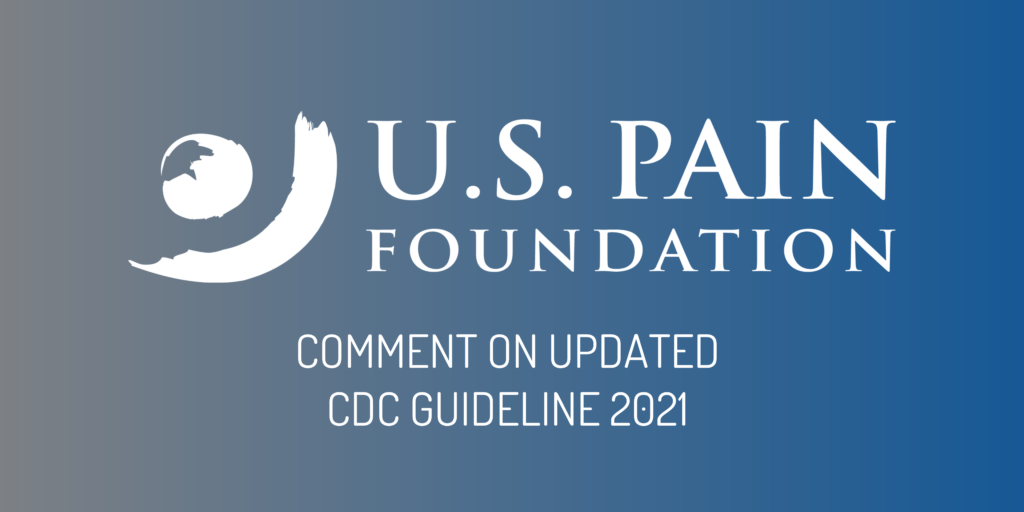
Note: The following has been submitted to the CDC in response to the organization’s Updated Draft CDC Guideline for Prescribing Opioids. To learn more and see how you can submit your own comment to the CDC, please click here.
The U.S. Pain Foundation is pleased to provide comments on the Centers for Disease Control and Prevention (CDC) National Center for Injury Prevention and Control (NCIPC)’s Updated Draft CDC Guideline for Prescribing Opioids announced at the Board of Scientific Counselors meeting on July 16, 2021. The U.S. Pain Foundation is the largest 501(c)(3) organization for people who live with chronic pain from a myriad of diseases, conditions, and serious injuries. Our mission is to connect, support, educate, and advocate for those living with chronic pain, as well as their caregivers and healthcare providers.
The U.S. Pain Foundation is gravely concerned that the Updated Draft Guideline presented and discussed at the meeting is virtually identical to the original 2016 Guideline. All of the serious problems identified by numerous researchers, clinicians, pain management experts (including problems identified by the HHS Pain Management Best Practices Inter-Agency Task Force (PMTF) in the 2019 review of the 2016 CDC Guideline), patient advocates, and patients over the past five years are still present in the new Updated Draft Guideline released on July 16. These problems include:
- Restricting authorship to non-pain management injury prevention and addiction specialists
- Bias in selection of evidence
- Inappropriate use of GRADE System — strong recommendations with weak or very weak evidence
- Biased focus on risks and harms of opioids with no discussion of benefits of opioids for pain relief when appropriately managed, or the risks and harms of enduring prolonged pain when other treatments have failed
- Arbitrary use of specific MME dose limits (“careful …when increasing dosage to ≥50 MME/day, and should avoid increasing dosage to ≥90 MME/day”). There is no scientific evidence supporting use of these MME dosages and even MME comparison and conversion has recently been called into question by the FDA. Further, there is wide variation in patient characteristics, disease and injury type, severity, and progression that is optimal for pain relief
- Opioid duration for acute pain depends on the severity of the injury, the type and complexity of the surgical procedure, and individual characteristics of the patient. There is no scientific basis to the strong statement that “One to three days or less will often be sufficient; more than seven days will rarely be needed”
- Exclusion of certain pain conditions (Cancer, Sickle Cell Disease, Palliative Care and End-of-Life Care) as more worthy of pain control where the stated “risks” and “harms” don’t apply. Pain is pain and must be considered on an individual basis. A person with any given pain condition could be in much worse pain for longer duration than a person with one of the excluded conditions
Since the introduction of the CDC Guideline in 2016, there has been overwhelming and widespread evidence of serious adverse consequences to thousands of pain patients including forced tapering, hundreds of documented suicides, sudden loss of access to medication triggering withdrawal, dismissal from physician practices, inability to find medical care, and loss of function and quality of life. The CDC, the FDA, patient advocates, pain and disease advocacy organizations, the PMTF, and even members of Congress and the White House have received numerous letters, email messages, and phone calls from desperate pain patients who have used opioids legally, safely and appropriately, in many cases for years, pleading for help and relief from their relentless pain.
Despite claims to make a concerted effort to include the views of a wide variety of pain management experts, pain advocates, and pain patients in the development of the Updated Draft CDC Guideline, the authors have produced a new version with very few changes.
Opioids certainly do not help everyone with chronic pain and for those who are helped by these medications, they do not completely eliminate their pain. Given the dearth of safe, effective therapeutic options for chronic pain, current best practice in pain management is widely recognized to be a multimodal, multidisciplinary, integrated model of care in which the healthcare provider, working with the patient, develops an individualized care plan that includes a combination of treatments selected from a broad range of therapeutic options. This approach is well-documented in the widely praised 2019 PMTF Report.
It is unfortunate and a missed opportunity that the Updated Draft CDC Guideline has not discussed nor recommended the wide range of therapeutic options for acute, subacute, or chronic pain that could be used to reduce or complement the use of opioids. Given the broad reach and influence of the CDC’s 2016 Guideline, the CDC’s endorsement of an integrated model of pain care including both pharmacological and non-pharmacological therapeutic options could help to break down barriers to access for many of these therapeutic options.
We hope the CDC will give these views serious consideration as it moves forward with this important work. Should we be able to provide additional information or assist the CDC’s efforts in any way, please feel free to contact me using the information listed below.
Sincerely,
Cindy Steinberg
Director of Policy & Advocacy
U.S. Pain Foundation
781-652-0146
cindy@uspainfoundation.org
